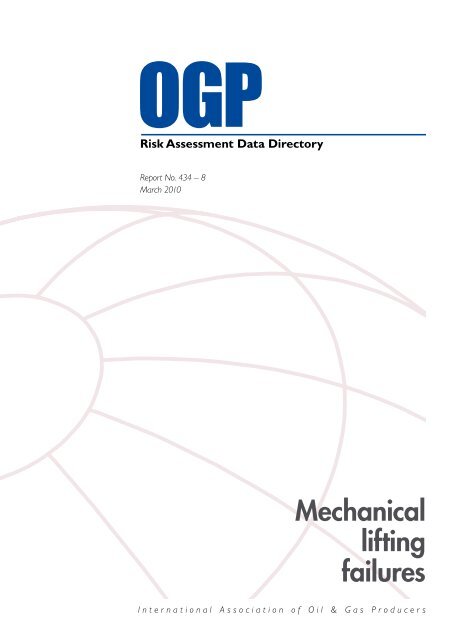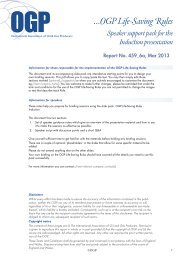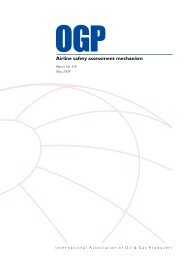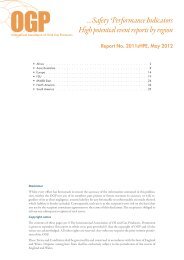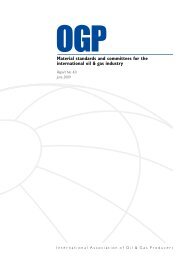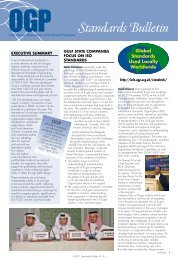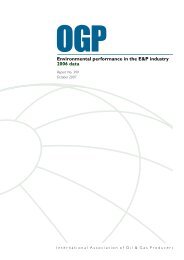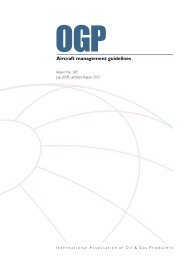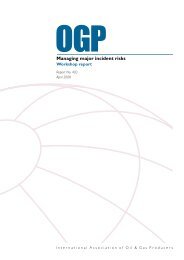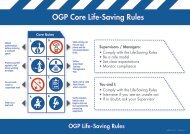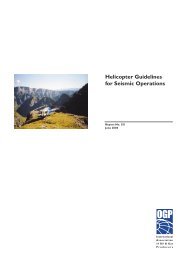Mechanical lifting failures - OGP
Mechanical lifting failures - OGP
Mechanical lifting failures - OGP
Create successful ePaper yourself
Turn your PDF publications into a flip-book with our unique Google optimized e-Paper software.
Risk Assessment Data Directory<br />
Report No. 434 – 8<br />
March 2010<br />
<strong>Mechanical</strong><br />
<strong>lifting</strong><br />
<strong>failures</strong><br />
I n t e r n a t i o n a l A s s o c i a t i o n o f O i l & G a s P r o d u c e r s
P ublications<br />
Global experience<br />
The International Association of Oil & Gas Producers has access to a wealth of technical<br />
knowledge and experience with its members operating around the world in many different<br />
terrains. We collate and distil this valuable knowledge for the industry to use as guidelines<br />
for good practice by individual members.<br />
Consistent high quality database and guidelines<br />
Our overall aim is to ensure a consistent approach to training, management and best practice<br />
throughout the world.<br />
The oil and gas exploration and production industry recognises the need to develop consistent<br />
databases and records in certain fields. The <strong>OGP</strong>’s members are encouraged to use the<br />
guidelines as a starting point for their operations or to supplement their own policies and<br />
regulations which may apply locally.<br />
Internationally recognised source of industry information<br />
Many of our guidelines have been recognised and used by international authorities and<br />
safety and environmental bodies. Requests come from governments and non-government<br />
organisations around the world as well as from non-member companies.<br />
Disclaimer<br />
Whilst every effort has been made to ensure the accuracy of the information contained in this publication,<br />
neither the <strong>OGP</strong> nor any of its members past present or future warrants its accuracy or will, regardless<br />
of its or their negligence, assume liability for any foreseeable or unforeseeable use made thereof, which<br />
liability is hereby excluded. Consequently, such use is at the recipient’s own risk on the basis that any use<br />
by the recipient constitutes agreement to the terms of this disclaimer. The recipient is obliged to inform<br />
any subsequent recipient of such terms.<br />
This document may provide guidance supplemental to the requirements of local legislation. Nothing<br />
herein, however, is intended to replace, amend, supersede or otherwise depart from such requirements. In<br />
the event of any conflict or contradiction between the provisions of this document and local legislation,<br />
applicable laws shall prevail.<br />
Copyright notice<br />
The contents of these pages are © The International Association of Oil and Gas Producers. Permission<br />
is given to reproduce this report in whole or in part provided (i) that the copyright of <strong>OGP</strong> and (ii)<br />
the source are acknowledged. All other rights are reserved.” Any other use requires the prior written<br />
permission of the <strong>OGP</strong>.<br />
These Terms and Conditions shall be governed by and construed in accordance with the laws of England<br />
and Wales. Disputes arising here from shall be exclusively subject to the jurisdiction of the courts of<br />
England and Wales.
RADD – <strong>Mechanical</strong> <strong>lifting</strong> <strong>failures</strong><br />
Contents:<br />
1.0 Introduction .......................................................................... 1<br />
1.1 Application ...................................................................................................... 1<br />
1.2 Definitions ....................................................................................................... 1<br />
2.0 Summary of Recommended Data............................................ 1<br />
3.0 Guidance on use of data ........................................................ 3<br />
3.1 General validity ............................................................................................... 3<br />
3.2 Uncertainties ................................................................................................... 3<br />
3.3 Use of the Data................................................................................................ 4<br />
3.4 Consequence Analysis of Objects Dropped Into the Sea........................... 4<br />
3.5 Kinetic energy ................................................................................................. 6<br />
4.0 Review of data sources ......................................................... 7<br />
5.0 References ............................................................................ 8<br />
©<strong>OGP</strong>
RADD – <strong>Mechanical</strong> <strong>lifting</strong> <strong>failures</strong><br />
Abbreviations:<br />
BOP<br />
DNV<br />
HSE<br />
QRA<br />
UKCS<br />
WOAD<br />
Blowout Preventer<br />
Det Norske Veritas<br />
(UK) Health and Safety Executive<br />
Quantitative Risk Assessment (sometimes Analysis)<br />
United Kingdom Continental Shelf<br />
World Offshore Accident Databank<br />
©<strong>OGP</strong>
RADD – <strong>Mechanical</strong> <strong>lifting</strong> <strong>failures</strong><br />
1.0 Introduction<br />
1.1 Application<br />
This datasheet presents information on the frequency of dropped objects resulting from<br />
the failure of <strong>lifting</strong> devices on offshore installations. Specifically it includes dropped<br />
load frequencies for the following types of <strong>lifting</strong> equipment:<br />
1. Main cranes<br />
2. Drilling derrick<br />
3. Other devices<br />
The data are derived from offshore operating experience in the UKCS over the period<br />
1980 to 1999. The data are intended to be applied in quantifying the risks from <strong>lifting</strong><br />
operations worldwide. Consideration should be given to factoring the data up or down<br />
where there is reasonable justification that the management of <strong>lifting</strong> operations is<br />
significantly poorer or safer that UKCS operations.<br />
1.2 Definitions<br />
• Dropped loads Refers to loads (objects) either unintentionally released from<br />
a <strong>lifting</strong> device or else swinging and impacting some part of<br />
the installation structure (or vessel, if the lift is to/from a<br />
vessel).<br />
• Lifting devices Main crane, derrick main hoisting assembly, and other <strong>lifting</strong><br />
devices (see below).<br />
• Other <strong>lifting</strong><br />
devices<br />
• Mobile<br />
Installations<br />
• Fixed<br />
Installations<br />
BOP cranes, gantry cranes, tuggers, and a range of portable<br />
devices, e.g winches, sling blocks, wirelines.<br />
The data for mobile installations are gathered almost entirely<br />
from experience in the operation of mobile offshore drilling<br />
units (MODUs). These include semi-submersibles, jackups,<br />
and drill ships.<br />
The data for fixed installations are gathered from a range of<br />
types of production installation ranging from integrated<br />
platforms to wellhead platforms. The data also include<br />
experience from FPSOs (floating production, storage and<br />
offloading vessels) and FSUs (floating storage units).<br />
“Main cranes” and “drilling derrick” referred to in Section 1.0 are considered self<br />
explanatory.<br />
2.0 Summary of Recommended Data<br />
Dropped object probabilities per lift on offshore installations are tabulated below for<br />
mobile installations and fixed installations, for different load weights and by <strong>lifting</strong><br />
device (main crane, drilling derrick, or other device).<br />
The data represent the probability of a dropped object per lift. Estimation of the<br />
dropped object frequency combines the probability of a dropped object per lift with the<br />
number of lifts carried out (for example, per year if the annual risk is required).<br />
Note that, for drops from the main crane, in general the frequency in the Total column is<br />
not the sum of the Installation, Sea and Vessel drop frequencies in the same row<br />
because not all main crane lifts are between vessel and installation (some are across<br />
©<strong>OGP</strong> 1
RADD – <strong>Mechanical</strong> <strong>lifting</strong> <strong>failures</strong><br />
the installation). Each frequency in the Total column is calculated from the total number<br />
of lifts, whereas the Sea and Vessel frequencies are calculated from the number of<br />
external lifts (between installation and vessel) only.<br />
Of the reported events on which the probabilities tabulated below are based, 10% of<br />
dropped objects on mobile installations and 20% of dropped objects on fixed<br />
installations resulted in all or part of the <strong>lifting</strong> device falling (see Section 1.2 above for<br />
the definition of “<strong>lifting</strong> device”).<br />
Load<br />
Weight<br />
100 te<br />
All<br />
Dropped Object Probabilities for Mobile Units (per lift)<br />
Lifting<br />
device<br />
Installatio<br />
n<br />
Drop Onto:<br />
Sea<br />
Vessel<br />
Total<br />
Main crane 3.2 × 10 -5 8.8 × 10 -6 1.1 × 10 -5 4.1 × 10 -5<br />
Drilling<br />
Derrick<br />
1.7 × 10 -5 7.3 × 10 -7 6.1 × 10 -8 1.8 × 10 -5<br />
Other Device 8.6 × 10 -5 1.1 × 10 -5 0* 9.7 × 10 -5<br />
Main crane 3.1 × 10 -6 2.0 × 10 -6 3.0 × 10 -6 5.4 × 10 -6<br />
Drilling<br />
Derrick<br />
3.6 × 10 -6 4.6 × 10 -7 0* 4.0 × 10 -6<br />
Other Device 7.6 × 10 -6 2.9 × 10 -6 0* 1.1 × 10 -5<br />
Main crane 1.2 × 10 -5 7.1 × 10 -6 9.5 × 10 -6 2.0 × 10 -5<br />
Drilling<br />
Derrick<br />
1.8 × 10 -6 0* 0* 1.8 × 10 -6<br />
Other Device 1.9 × 10 -6 0* 0* 1.9 × 10 -6<br />
Main crane 2.8 × 10 -4 0* 0* 2.8 × 10 -4<br />
Drilling<br />
Derrick<br />
4.7 × 10 -3 1.4 × 10 -3 0* 6.1 × 10 -3<br />
Other Device 4.9 × 10 -4 2.4 × 10 -4 0* 7.3 × 10 -4<br />
Main crane 8.5 × 10 -6 3.3 × 10 -6 4.6 × 10 -6 1.2 × 10 -5<br />
Drilling<br />
Derrick<br />
1.1 × 10 -5 6.7 × 10 -7 3.0 × 10 -8 1.1 × 10 -5<br />
Other Device 4.5 × 10 -5 6.5 × 10 -6 0* 5.2 × 10 -5<br />
Total All 1.2 × 10 -5 1.4 × 10 -6 9.4 × 10 -7 1.4 × 10 -5<br />
2<br />
©<strong>OGP</strong>
RADD – <strong>Mechanical</strong> <strong>lifting</strong> <strong>failures</strong><br />
Load<br />
Weight<br />
100 te<br />
All<br />
Dropped Object Probabilities for Fixed Installations (per lift)<br />
Lifting<br />
device<br />
Installatio<br />
n<br />
Drop Onto:<br />
Sea<br />
Vessel<br />
Total<br />
Main crane 3.8 × 10 -5 6.9 × 10 -6 1.1 × 10 -5 4.5 × 10 -5<br />
Drilling<br />
Derrick<br />
1.7 × 10 -5 1.2 × 10 -7 1.2 × 10 -7 1.7 × 10 -5<br />
Other Device 1.0 × 10 -4 4.2 × 10 -6 6.1 × 10 -7 1.0 × 10 -4<br />
Main crane 4.7 × 10 -6 1.7 × 10 -6 5.1 × 10 -6 7.9 × 10 -6<br />
Drilling<br />
Derrick<br />
2.7 × 10 -6 1.5 × 10 -7 0* 2.9 × 10 -6<br />
Other Device 1.4 × 10 -5 0* 7.4 × 10 -7 1.5 × 10 -5<br />
Main crane 1.0 × 10 -5 6.2 × 10 -6 1.6 × 10 -5 2.0 × 10 -5<br />
Drilling<br />
Derrick<br />
1.2 × 10 -6 0* 0* 1.2 × 10 -6<br />
Other Device 2.6 × 10 -5 0* 0* 2.6 × 10 -5<br />
Main crane 9.3 × 10 -5 0* 0* 9.3 × 10 -5<br />
Drilling<br />
Derrick<br />
0* 0* 0* 0<br />
Other Device 6.1 × 10 -4 0* 0* 6.1 × 10 -4<br />
Main crane 1.0 × 10 -5 2.8 × 10 -6 6.4 × 10 -6 1.5 × 10 -5<br />
Drilling<br />
Derrick<br />
9.6 × 10 -6 1.2 × 10 -7 6.1 × 10 -8 9.7 × 10 -6<br />
Other Device 5.7 × 10 -5 2.0 × 10 -6 5.8 × 10 -7 6.0 × 10 -5<br />
Total All 1.4 × 10 -5 8.8 × 10 -7 1.6 × 10 -6 1.6 × 10 -5<br />
• In both of the above tables, either there are no recorded incidents, or the incident is<br />
not credible. If the analyst believes it is credible, then a suitable frequency could be<br />
obtained by pro rating a non-zero frequency, e.g. using the “All” frequencies.<br />
3.0 Guidance on use of data<br />
3.1 General validity<br />
The frequencies given are based on analysis of offshore <strong>lifting</strong> operations on the UK<br />
continental shelf (see Section 4.0). They may be applied to <strong>lifting</strong> operations in other<br />
offshore regions which comply with recognised industry good practice, as it is applied<br />
in the UKCS.<br />
The data for dropped objects from derricks may be applied to onshore drilling<br />
operations where these are similar to offshore drilling activities and equipment. The<br />
data for dropped objects from main cranes and other <strong>lifting</strong> devices are not applicable<br />
to onshore <strong>lifting</strong> operations because the equipment used is unlikely to be similar to<br />
that used offshore.<br />
3.2 Uncertainties<br />
Sources of uncertainties in the data include statistical variation and the similarity<br />
between the operations and equipment under analysis and those represented by the<br />
database.<br />
©<strong>OGP</strong> 3
RADD – <strong>Mechanical</strong> <strong>lifting</strong> <strong>failures</strong><br />
The calculated frequencies are derived from 1637 dropped object events in a total<br />
experience of 3063 installation-years. This implies a total of about 111 million <strong>lifting</strong><br />
operations. For fixed platforms there were 690 dropped objects in 1857 platform years,<br />
for mobile installations 947 events in 1206 installation-years experience. Therefore the<br />
statistical uncertainty in the overall frequencies is relatively small. Some of the specific<br />
risks are calculated from the experience of a small number of representative dropped<br />
object accidents and correspondingly the uncertainty in the risk will be more significant.<br />
The risks with the higher uncertainty are those with the lower likelihoods shown in<br />
Section 2.0.<br />
The data in the database reflect <strong>lifting</strong> equipment in operation in the UKCS. While there<br />
is a degree of variation in the equipment used in the UKCS, it is similar in that the vast<br />
majority is maintained and operated in accordance with international certification and<br />
UK legal requirements. Competence requirements for operations and maintenance<br />
personnel are generally enforced, and all operations are conducted in accordance with<br />
documented procedures reflecting good industry practice. Where operations outside<br />
the UK can be assumed to follow a similar standard of operation and maintenance, it is<br />
reasonable to assume the data are valid for assessment of the dropped object risks.<br />
3.3 Use of the Data<br />
The dropped object probability values are an input to QRA and are used to calculate the<br />
frequency of the initiating event for dropped object risks. The consequence of dropped<br />
objects depends on the impact energy and the people, equipment and structures<br />
impacted by the objects dropped.<br />
For an object falling through air, the impact energy is calculated as the product of the<br />
mass of the object, the height and acceleration due to gravity (≈ 10 m/s 2 ). Generally,<br />
people struck by falling objects can be assumed to be fatally injured, and objects<br />
striking hydrocarbon equipment will cause a hydrocarbon release. Damage to<br />
structures or other equipment struck by dropped objects may require a specific<br />
assessment of the resistance of the object impacted and/or the potential for a release<br />
from live equipment struck. However, incidents involving hydrocarbon releases are<br />
already included in the hydrocarbon release frequencies, so such an assessment is only<br />
recommended where the analyst identifies a particular vulnerability to dropped objects,<br />
or a stand-alone dropped objects study is being carried out.<br />
When using dropped object risks in a total risk assessment for a facility, the risks to<br />
people from dropped objects may also be included in the statistical data on<br />
occupational accidents. Where this is the case, it is appropriate to disregard the<br />
calculated dropped object risk for immediate fatalities.<br />
In the event of a dropped object, the <strong>lifting</strong> equipment will be out of service until the<br />
incident can be investigated and any repair can be implemented. An operational risk<br />
assessment should take account of this. Even for minor dropped objects with no<br />
apparent damage, equipment downtime will be of the order of several days. In the event<br />
of a fatality or major equipment damage, the equipment is likely to be out of service for<br />
several weeks.<br />
3.4 Consequence Analysis of Objects Dropped Into the Sea<br />
The calculation of the consequences of objects dropped into the sea is more complex.<br />
For heavy lifts (e.g. BOP or xmas tree) over the sea it is standard practice that these are<br />
not carried out over vulnerable subsea equipment. Thus care is required in assessing<br />
4<br />
©<strong>OGP</strong>
RADD – <strong>Mechanical</strong> <strong>lifting</strong> <strong>failures</strong><br />
whether a dropped BOP or other heavy load can cause damage to subsea equipment or<br />
if the precautions carried out are adequate. For other lifts, the following approach can<br />
be followed to calculate locations at risk from dropped object impact.<br />
Heavy, dense objects (such as BOPs) can be assumed to fall vertically and will damage<br />
any infrastructure immediately beneath the drop site. Some other objects, such as pipe<br />
sections and scaffolding poles, may travel a significant horizontal distance through the<br />
water as they descend. The following model is taken from a DNV Recommended<br />
Practice [4].<br />
The analysis assumes that the excursion made by a dropped object can be represented<br />
by a normal distribution:<br />
where x is the horizontal excursion and δ the standard deviation. The standard<br />
deviation is sensitive to the weight and shape of the object, and the water depth (d). The<br />
derivation of δ is given by:<br />
Here α is the spread in the descent angle given in Table 3.1.<br />
Case<br />
Object Shape<br />
Description<br />
Table 3.1 Calculation of Descent Angles<br />
Weight<br />
(tonnes)<br />
Descent<br />
Angle<br />
Spread<br />
(deg)<br />
1 < 2 15<br />
2 Flat/long shaped<br />
2 – 8 9<br />
3<br />
> 8 5<br />
4 < 2 10<br />
5 Box/round shaped<br />
2 – 8 5<br />
6<br />
> 8 3<br />
7 Box/round shaped >> 8 2<br />
The probability that the object lands within a horizontal distance, r, of the drop point is<br />
given by the equation:<br />
When considering object excursion in deep water the spreading of long/flat objects,<br />
cases no. 1 to 3, will increase down to a depth of approximately 180 m. Below this depth<br />
spreading does not increase significantly and may conservatively be set to be vertical.<br />
For a riser, any vertical sections will complicate the hit calculations. One way of<br />
calculating the probability of hit to a riser is to:<br />
1. Split the riser into different sections (normally into vertical section(s) and horizontal<br />
section(s)), and<br />
2. Calculate the hit probability of these sections at the respective water depths. The<br />
final probability is then found as the sum of all the probabilities for the different<br />
sections.<br />
The effect of currents will become more pronounced in deep water. The time for an<br />
object to hit the seabed will increase as the depth increases. This means that any<br />
©<strong>OGP</strong> 5
RADD – <strong>Mechanical</strong> <strong>lifting</strong> <strong>failures</strong><br />
current may increase the excursion (in one direction). At 1000 m depth the excursion is<br />
found to increase 10 to 25 metres for an average current velocity of 0.25 m/s and up to<br />
200 m for a current of 1.0 m/s.<br />
The effect of currents may be included if one dominant current direction can be<br />
identified. This may be applicable for rig operations for shorter periods, for example<br />
during drilling, completion and intervention/construction above subsea wells. However,<br />
for a dropped object assessment on a fixed platform, seasonal changes in current<br />
directions may be difficult to incorporate.<br />
When establishing a "safe distance" away from activities the effect of currents should<br />
be included. A conservative object excursion should be determined, including<br />
consideration of the drift of the objects before sinking, uncertainties in the navigation of<br />
anchor handling vessel, etc.<br />
3.5 Kinetic energy<br />
A dropped object from a crane and hitting the topsides will have a kinetic (impact)<br />
energy E k given by:<br />
E k = m.g.h<br />
where: E k = kinetic energy at impact (J)<br />
m = mass of the object (kg)<br />
g = gravitation acceleration (9.81 m/s 2 )<br />
h = height from release point to point of impact (m)<br />
The maximum impact force depends on the object itself and the orientation when<br />
hitting, and can be found from structural collapse calculations. The impact resistance of<br />
structures can be found from deterministic structural strength calculations.<br />
The kinetic energy of a dropped object on subsea installations depends on the velocity<br />
through the water, the shape of the object and the mass in water. After approximately 50<br />
- 100 metres, a sinking object will usually have reached its terminal velocity.<br />
The terminal velocity is found when the object is in balance with respect to gravitation<br />
forces, displaced volume and flow resistance. When the object has reached this<br />
balance, it falls with a constant velocity, its terminal velocity. This can be expressed by<br />
the following equation:<br />
where: m = mass of the object (kg)<br />
g = gravitation acceleration (9.81 m/s 2 )<br />
V = volume of the object (the volume of the displaced water) (m 3 )<br />
ρ water = density of water (typically 1025 kg/m 3 for the North Sea)<br />
C D = drag coefficient of the object<br />
A = projected area of the object in the flow-direction (m 2 )<br />
v T = terminal velocity through the water (m/s)<br />
The kinetic energy of the object, E T , at the terminal velocity is:<br />
Combining these to equations gives the following expression for the terminal energy:<br />
6<br />
©<strong>OGP</strong>
RADD – <strong>Mechanical</strong> <strong>lifting</strong> <strong>failures</strong><br />
In addition to the terminal energy, the kinetic energy that is effective in an impact, E E ,<br />
includes the energy of added hydrodynamic mass, E A . The added mass may become<br />
significant for large volume objects such as containers. The effective impact energy<br />
becomes:<br />
where m a is the added mass (kg).<br />
Tubulars are assumed to be waterfilled unless it is documented that the closure is<br />
sufficiently effective during the initial impact with the surface, and that it will continue to<br />
stay close in the sea.<br />
Intact, sealed containers may not sink at all.<br />
The drag and added mass coefficients are dependent of the geometry of the object. The<br />
drag coefficients will affect the objects terminal velocity, while the added mass only has<br />
influence as the object hit something and is brought to a stop. Table 3.2 gives typical<br />
values of these coefficients.<br />
Table 3.2 Drag and Added Mass Coefficients<br />
Object Case Description C d C m<br />
(as Table 3.1)<br />
1,2,3 Slender shape 0.7 - 1.5 0.1 - 1.0<br />
4,5,6,7 Box shaped 1.2 - 1.3 0.6 - 1.5<br />
All<br />
Misc. shapes (spherical to<br />
complex)<br />
0.6 - 2.0 1.0 - 2.0<br />
It is recommended that a value of 1.0 is initially used for C d , after which the effect of a<br />
revised drag coefficient should be evaluated.<br />
Small equipment items (fittings, scaffolding clamps, etc.) are unlikely to do any damage<br />
to subsea equipment if they fall into the sea.<br />
4.0 Review of data sources<br />
The recommended probabilities of dropped objects presented in Section 2.0 have been<br />
calculated by combining recorded incidents of dropped objects from the WOAD [1] and<br />
the UK HSE’s ORION databases with data on the number of lifts carried out.<br />
The incidents have been analysed by DNV and full reports are available in HSE research<br />
reports [2] and [3].<br />
The numbers of lifts per year for mobile installations (Table 4.1) are based on observed<br />
data collected for DNV by a drilling contractor. The number of lifts per year on fixed<br />
installations (Table 4.2) are estimated by interpretation of the data on mobile<br />
installations combined with reasonable assumptions and consequently should be<br />
treated with more caution. The numbers of “installation years” represented by the<br />
ORION and WOAD data are provided by the HSE from primary records.<br />
The experience data for mobile installations were collected over the period 1980 to 1998;<br />
those for fixed installations were collected over the period 1991 to 1999.<br />
Of the main crane lifts, 46% were to or from a supply vessel and 54% were across the<br />
installation. Of the lifts to and from supply vessels, 75% were of containers, baskets<br />
and tanks; the remainder were casing, drillpipe, collars, etc.<br />
©<strong>OGP</strong> 7
RADD – <strong>Mechanical</strong> <strong>lifting</strong> <strong>failures</strong><br />
Table 4.1 Observed Frequencies of Lifting Operations on Mobile<br />
Installations<br />
Lifting Device<br />
Lifts per Year<br />
Main Crane 24,480<br />
Drilling Derrick 28,670<br />
Other Lifting Device 3,650<br />
Total 56,800<br />
Table 4.2 Calculated Frequencies of Lifts using Main Crane on Fixed<br />
Installations (per year)<br />
Type of installation<br />
Lifts to / from<br />
Vessels<br />
Internal Lifts<br />
Fixed (no drilling) 5520 8,674<br />
Fixed (drilling for 6 months /<br />
year)<br />
8400 10,937<br />
Wellhead platform 552 867<br />
The UK HSE has also published accident data for more recent period up to and<br />
including 2004/2005 [5, 6. 7] These data have not been subjected to the same detailed<br />
statistical analysis as the data presented in this report and for this reason the more<br />
recent experience is not included here. However a review of the data over the period<br />
1980 to 2005 shows that although there is considerable variation from year to year, the<br />
average frequency of dropped objects per installation-year remains approximately<br />
constant. This is consistent with the observation that the technology and <strong>lifting</strong><br />
procedures used on offshore installations have not changed to any great extent over the<br />
period the data were collected.<br />
5.0 References<br />
1. DNV, 2006. WOAD, Worldwide Offshore Accident Databank, version 5.0.1.<br />
2. DNV, 1999. Accident statistics for mobile offshore units on the UK continental shelf in<br />
1980-98, HSE Offshore Technology Report OTO 2000/091 / DNV Report No. 99-2490.<br />
3. DNV, 2002. Accident statistics for fixed offshore units on the UK Continental Shelf 1991-<br />
1999, HSE Offshore Technology Report OTO 2002/012.<br />
4. DNV, 2002. Risk Assessment of Pipeline Protection, Recommended Practice No. DNV-<br />
RP-F107 (amended).<br />
5. HSE, 2006. Offshore Injury, Ill Health and Incident Statistics 2004/2005 (provisional data),<br />
HID Statistical Report HSR 2005 001.<br />
6. HSE, 2005. Accident statistics for Floating Offshore Units on the UK Continental Shelf<br />
1980-2003, Research Report 353, prepared by Det Norske Veritas for the Health and<br />
Safety Executive.<br />
7. HSE, 2005. Accident statistics for Fixed Offshore Units on the UK Continental Shelf 1980 –<br />
2003, Research Report 349, prepared by Det Norske Veritas for the Health and Safety<br />
Executive.<br />
8<br />
©<strong>OGP</strong>
For further information and publications,<br />
please visit our website at<br />
www.ogp.org.uk
209-215 Blackfriars Road<br />
London SE1 8NL<br />
United Kingdom<br />
Telephone: +44 (0)20 7633 0272<br />
Fax: +44 (0)20 7633 2350<br />
165 Bd du Souverain<br />
4th Floor<br />
B-1160 Brussels, Belgium<br />
Telephone: +32 (0)2 566 9150<br />
Fax: +32 (0)2 566 9159<br />
Internet site: www.ogp.org.uk<br />
e-mail: reception@ogp.org.uk


